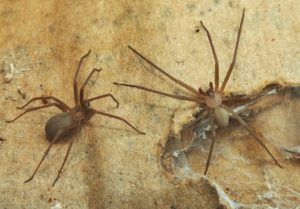The Arizona brown spider is an interesting creature from the Sicariidae family. If you’re curious about where it lives, you’d mostly spot it in Arizona. In this blog post, we’ll share fun facts about this unique spider!

Loxosceles arizonica
The sacs where the eggs are laid are yellow.
After hatching, they leave their original web.
As they primarily hunt their prey, they generally do not construct elaborate webbing.
Yes, Arizona Brown Spiders are venomous. Their venom can affect humans. Like all other Sicariidae species, their venom has the capability of necrotizing tissue.
Yes, Arizona Brown Spiders can bite. While bites are rare, they can cause discomfort to humans.
The Arizona Brown Spider plays a crucial role in maintaining the ecological balance in its habitat. By preying on ants and other small insects, they help control pest populations, contributing to a healthy environment.
Natural Predators: Their life in the wild is fraught with dangers, as they encounter natural predators such as wolf spiders and praying mantis. These predators play an essential role in controlling the population of Arizona Brown Spiders, ensuring a balanced ecosystem.
Prey-Predator Dynamics: The dynamics between the Arizona Brown Spider and its prey and predators are a fascinating aspect of their ecology. Their venomous bite allows them to efficiently subdue prey, while their predators act as a natural check, preventing their overpopulation.
Relationship with Humans: While their venom can cause harm to humans, incidents of bites are extremely rare. Humans play a significant role in influencing the habitats of these spiders, highlighting the importance of understanding and coexisting with these creatures.
| Lifespan | 1-2 years |
| Distribution | United States (Arizona, California, New Mexico, and Texas) and Mexico |
| Habitat | Arid and semi-arid regions |
| Common Predators | Wolf spiders and praying mantis |
| Diet | Ants, especially carpenter ants |
In summary, the Arizona Brown Spider stands as a captivating species within the arachnid world, embodying a unique blend of survival strategies, ecological significance, and a complex relationship with the environment and humans.
Image Source: bugguide.net, inaturalist.org, bloximages.chicago2.vip.townnews.com
The Arizona brown spider is an interesting creature from the Sicariidae family. If you’re curious about where it lives, you’d mostly spot it in Arizona. In this blog post, we’ll share fun facts about this unique spider!

Loxosceles arizonica
The sacs where the eggs are laid are yellow.
After hatching, they leave their original web.
As they primarily hunt their prey, they generally do not construct elaborate webbing.
Yes, Arizona Brown Spiders are venomous. Their venom can affect humans. Like all other Sicariidae species, their venom has the capability of necrotizing tissue.
Yes, Arizona Brown Spiders can bite. While bites are rare, they can cause discomfort to humans.
The Arizona Brown Spider plays a crucial role in maintaining the ecological balance in its habitat. By preying on ants and other small insects, they help control pest populations, contributing to a healthy environment.
Natural Predators: Their life in the wild is fraught with dangers, as they encounter natural predators such as wolf spiders and praying mantis. These predators play an essential role in controlling the population of Arizona Brown Spiders, ensuring a balanced ecosystem.
Prey-Predator Dynamics: The dynamics between the Arizona Brown Spider and its prey and predators are a fascinating aspect of their ecology. Their venomous bite allows them to efficiently subdue prey, while their predators act as a natural check, preventing their overpopulation.
Relationship with Humans: While their venom can cause harm to humans, incidents of bites are extremely rare. Humans play a significant role in influencing the habitats of these spiders, highlighting the importance of understanding and coexisting with these creatures.
| Lifespan | 1-2 years |
| Distribution | United States (Arizona, California, New Mexico, and Texas) and Mexico |
| Habitat | Arid and semi-arid regions |
| Common Predators | Wolf spiders and praying mantis |
| Diet | Ants, especially carpenter ants |
In summary, the Arizona Brown Spider stands as a captivating species within the arachnid world, embodying a unique blend of survival strategies, ecological significance, and a complex relationship with the environment and humans.
Image Source: bugguide.net, inaturalist.org, bloximages.chicago2.vip.townnews.com